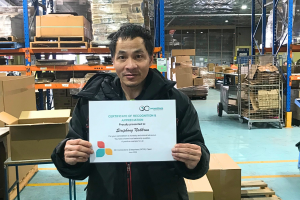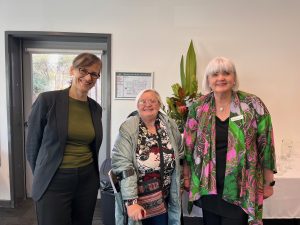Although the reality of our declining environment has been known for many years, strong governmental, global action has only recently been pushed to urgency.
As politicians debated whether climate change was real, local enterprises and grassroots organisations started looking for fresh opportunities to support their communities by reducing landfill and pollution.
Grassroots organisations and social enterprises have been putting in the work to kickstart a circular economy model that benefits the environment and our communities. A circular economy, where products are re-purposed back into the market instead of becoming waste, creates more jobs, grows our local economy, and improves long-term health outcomes by lowering carbon emissions.
OC Connections Enterprises has provided meaningful employment for people living with disabilities for many years, but five years ago, we decided to expand our impact by asking the question:
How can we create more opportunities for employment in the community, while working towards a greener future?
In November 2022, after years of rigorous research and designing, we released our first recycled product to the market: OC Eco T-Top Bollards.
It was an Australian-first initiative, diverting single-use traffic bollards from landfill, with triple-bottom lines: social, economic and environmental. Our resource recovery model generates more work for our employees. We use local manufacturing partners to utilise the recycled materials for new bollards, secondary products, and alternate market uses, circulating the benefits back into our local economy. In one year, we rerouted 20,000 kilos of plastic from landfill, reducing fossil fuels by over 41,000 kilos.
At the most recent ecologiQ Conference, hosted by the Victoria’s Big Build, General Manager of OCCE Steve Batinsky explained:
“Bollards don’t have a long lifespan because they’re in high impact environments… we identified that the waste could be a resource.”
A circular economy understands that there is value in the resources and goods that many consider ‘waste’, and that value can provide benefits beyond waste reduction and minimising landfill.
Realistically, manufacturers should be designing products with a plan for disassembly. Finding second-hand goods, metals and plastics should be at the forefront of product manufacturing. Guiding assets through a circular model reduces waste and creates opportunities for re-using and re-purposing.
Additionally, for organisations taking action to better our environment, opening pathways for organisations that want to contribute to a greener future but are concerned about the time and financial commitment. The circular economy model must bring together local, national and global entities to ensure the benefits of sustainable practices find stability in our growing market.
Until circular product design and stronger governmental policy take the lead, grassroots and social enterprises like OCCE will be finding treasure in, what many consider, trash, and using these opportunities to boost our local economy and support our communities.





